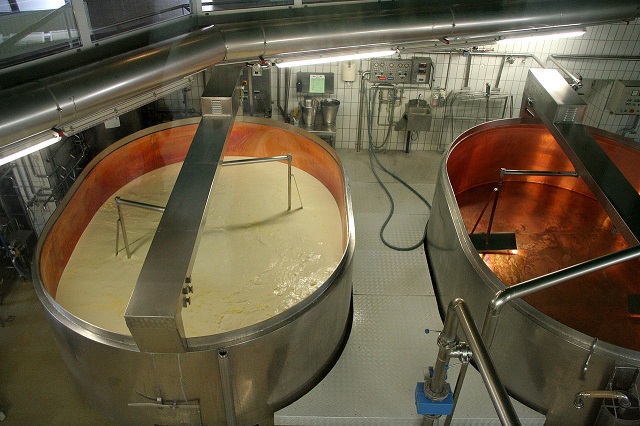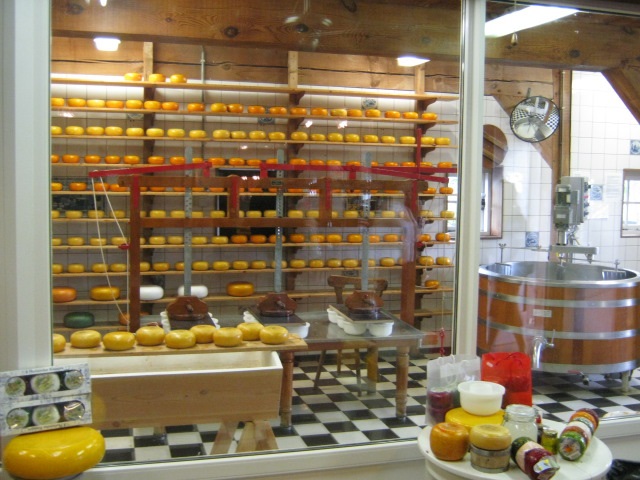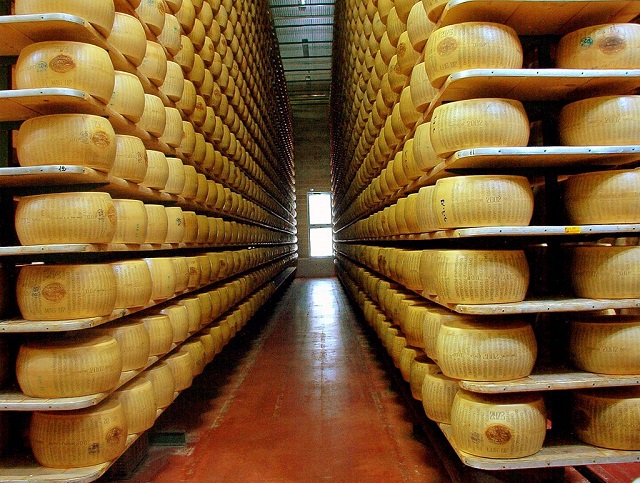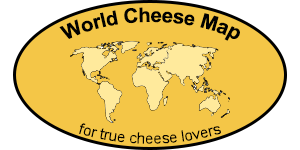
Curdling
A required step in cheesemaking is separating the milk into solid curds and liquid whey. Usually this is done by acidifying (souring) the milk and adding rennet. The acidification can be accomplished directly by the addition of an acid, such as vinegar, in a few cases (paneer, queso fresco). More commonly starter bacteria are employed instead which convert milk sugars into lactic acid. The same bacteria (and the enzymes they produce) also play a large role in the eventual flavor of aged cheeses. Most cheeses are made with starter bacteria from the Lactococcus, Lactobacillus, or Streptococcus families. Swiss starter cultures also include Propionibacter shermani, which produces carbon dioxide gas bubbles during aging, giving Swiss cheese or Emmental its holes (called “eyes”).
Some fresh cheeses are curdled only by acidity, but most cheeses also use rennet. Rennet sets the cheese into a strong and rubbery gel compared to the fragile curds produced by acidic coagulation alone. It also allows curdling at a lower acidity – important because flavor-making bacteria are inhibited in high-acidity environments. In general, softer, smaller, fresher cheeses are curdled with a greater proportion of acid to rennet than harder, larger, longer-aged varieties.
While rennet was traditionally produced via extraction from the inner mucosa of the fourth stomach chamber of slaughtered young, unweaned calves, most rennet used today in cheesemaking is produced recombinantly. The majority of the applied chymosin is retained in the whey and, at most, may be present in cheese in trace quantities. In ripe cheese, the type and provenance of chymosin used in production cannot be determined.
Curd processing

At this point, the cheese has set into a very moist gel. Some soft cheeses are now essentially complete: they are drained, salted, and packaged. For most of the rest, the curd is cut into small cubes. This allows water to drain from the individual pieces of curd.
Some hard cheeses are then heated to temperatures in the range of 35-55 °C (95-131 °F). This forces more whey from the cut curd. It also changes the taste of the finished cheese, affecting both the bacterial culture and the milk chemistry. Cheeses that are heated to the higher temperatures are usually made with thermophilic starter bacteria that survive this step – either Lactobacilli or Streptococci.
Salt has roles in cheese besides adding a salty flavor. It preserves cheese from spoiling, draws moisture from the curd, and firms cheese’s texture in an interaction with its proteins. Some cheeses are salted from the outside with dry salt or brine washes. Most cheeses have the salt mixed directly into the curds.
Other techniques influence a cheese’s texture and flavor. Some examples are :
- Stretching: (Mozzarella, Provolone) The curd is stretched and kneaded in hot water, developing a stringy, fibrous body.
- Cheddaring: (Cheddar, other English cheeses) The cut curd is repeatedly piled up, pushing more moisture away. The curd is also mixed (or milled) for a long time, taking the sharp edges off the cut curd pieces and influencing the final product’s texture.
- Washing: (Edam, Gouda, Colby) The curd is washed in warm water, lowering its acidity and making for a milder-tasting cheese.
Most cheeses achieve their final shape when the curds are pressed into a mold or form. The harder the cheese, the more pressure is applied. The pressure drives out moisture – the molds are designed to allow water to escape – and unifies the curds into a single solid body.
Ripening

A newborn cheese is usually salty yet bland in flavor and, for harder varieties, rubbery in texture. These qualities are sometimes enjoyed – cheese curds are eaten on their own – but normally cheeses are left to rest under controlled conditions. This aging period (also called ripening, or, from the French, affinage) lasts from a few days to several years. As a cheese ages, microbes and enzymes transform texture and intensify flavor. This transformation is largely a result of the breakdown of casein proteins and milkfat into a complex mix of amino acids, amines, and fatty acids.
Some cheeses have additional bacteria or molds intentionally introduced before or during aging. In traditional cheesemaking, these microbes might be already present in the aging room; they are simply allowed to settle and grow on the stored cheeses. More often today, prepared cultures are used, giving more consistent results and putting fewer constraints on the environment where the cheese ages. These cheeses include soft ripened cheeses such as Brie and Camembert, blue cheeses such as Roquefort, Stilton, Gorgonzola, and washed-rind cheeses such as Limburger.
Quality control
Cheesemakers must be skilled in the grading of cheese to assess quality, defects and suitability for release from the maturing store for sale. The grading process is one of sampling by sight, smell, taste and texture. Part of the cheesemaker’s skill lies in the ability to predict when a cheese will be ready for sale or consumption, as the characteristics of cheese change constantly during maturation.
Cheesemaker
A cheesemaker is a person who has developed the knowledge and skills required to convert milk into cheese, by controlling precisely the types and amounts of ingredients used, and the parameters of the cheesemaking process, to make specific types and qualities of cheese. Most cheesemakers by virtue of their knowledge and experience are adept at making particular types of cheese.
Credits: Wikipedia
